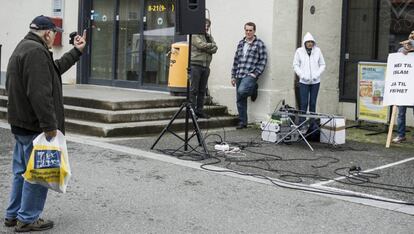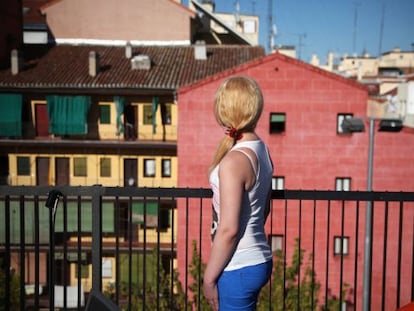A finger for fascists: Son of Spanish refugees confronts neo-Nazis in Norway
Iconic shot of Louis Eriksen making a gesture to an anti-Islamic movement goes viral

On Saturday, September 23, a potentially violent confrontation was simmering in the main square of the Norwegian town of Kongsberg, 80 kilometers from Oslo. The extreme-right group Stop the Islamification of Norway (SIAN) and the Refugee Welcome to Kongsberg movement faced each other across the square, each with stalls peddling their distinct points of view.
Also on the scene were a number of journalists and a rather large group of policemen primed for trouble following the disturbances that took place in August, when an influx of refugees coincided with the country’s election campaigns.
With the help of loudspeakers and banners, members of SIAN aired their “No to Islam, Yes to freedom” point of view while the pro-refugee delegation responded with music and enjoyed the support of the crowd – particularly that of one elderly gentleman, carrying the morning’s shopping, who stepped forward into no-man’s-land to give the ultra-right group the finger.
I don’t like these movements against refugees. That was obvious from what I did. And I would do it again Louis Eriksen
The defiant gesture was captured by photographer Irene Mjøseng and subsequently went viral on social media sites. “Photograph of the year?” tweeted Norwegian writer Tom Egeland. “I applaud Irene Mjøseng for this wonderful photo.”
It was a brave gesture, undoubtedly fueled by the elderly gentleman’s past. Known today as Louis Eriksen, 76, he was, in fact, born Louis Villalonga in Marseille, the son of refugees from the Spanish Civil War. He arrived in Norway in 1948, thanks to Den Norske Spaniakomitéen, an association working with the anti-Franco movement in Spain. Once there, he was taken in by a couple in Oslo, and adopted their surname, Eriksen. In 1964, he came to the town of Kongsberg, where he found a job in the Hotel Grand and met the love of his life, Jorunn.
“I don’t like these movements against refugees. That was obvious from what I did. And I would do it again,” he told EL PAÍS, his eyes bright with emotion. “They treat Muslims like third-class citizens but they are not. These people forget how the Norwegians moved to America to escape poverty. This is the same. Most of the refugees are poor. They are economic refugees.”
The neo-Nazi movement in Norway is small but noticeable. The photo has hit where it hurts Photographer Irene Mjøseng
Louis has become a digital icon as well as something of a spokesman for the pro-refugee movement. “The current situation has no equivalent,” he says. “Previously, refugees were mainly European and there weren’t so many of them. Now they come from all over the world. And attitudes toward them have deteriorated. I’m satisfied with what I did and I think it’s good that the image has spread on social media. I hope it will open people’s eyes and make them think a little more about what’s going on around us.”
Meanwhile, Mjøseng, who took the photo, says: “It’s fascinating how a photograph can capture the essence of a situation. We never dreamed that the photo of the SIAN demonstration and Louis’s gesture would reach so many people. The neo-Nazi movement in Norway is small but noticeable. The photo has hit where it hurts. A lot of people wanted to express their opposition to the anti-refugee movement but didn’t dare. This photo offers hope because it shows a retired person standing up for what he believes in, without fear or regret.”
English version by Heather Galloway.
Tu suscripción se está usando en otro dispositivo
¿Quieres añadir otro usuario a tu suscripción?
Si continúas leyendo en este dispositivo, no se podrá leer en el otro.
FlechaTu suscripción se está usando en otro dispositivo y solo puedes acceder a EL PAÍS desde un dispositivo a la vez.
Si quieres compartir tu cuenta, cambia tu suscripción a la modalidad Premium, así podrás añadir otro usuario. Cada uno accederá con su propia cuenta de email, lo que os permitirá personalizar vuestra experiencia en EL PAÍS.
¿Tienes una suscripción de empresa? Accede aquí para contratar más cuentas.
En el caso de no saber quién está usando tu cuenta, te recomendamos cambiar tu contraseña aquí.
Si decides continuar compartiendo tu cuenta, este mensaje se mostrará en tu dispositivo y en el de la otra persona que está usando tu cuenta de forma indefinida, afectando a tu experiencia de lectura. Puedes consultar aquí los términos y condiciones de la suscripción digital.
More information
Archived In
Últimas noticias
Most viewed
- Reinhard Genzel, Nobel laureate in physics: ‘One-minute videos will never give you the truth’
- Oona Chaplin: ‘I told James Cameron that I was living in a treehouse and starting a permaculture project with a friend’
- Pablo Escobar’s hippos: A serious environmental problem, 40 years on
- Why we lost the habit of sleeping in two segments and how that changed our sense of time
- Chevy Chase, the beloved comedian who was a monster off camera: ‘Not everyone hated him, just the people who’ve worked with him’










































